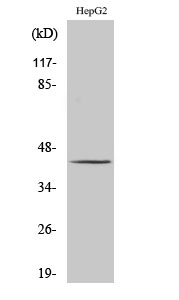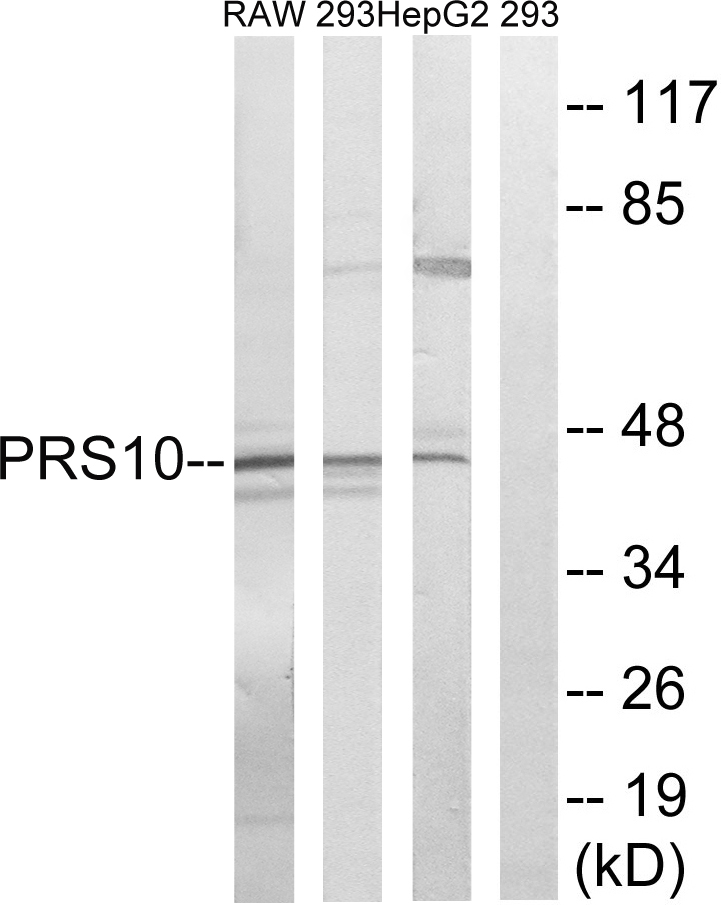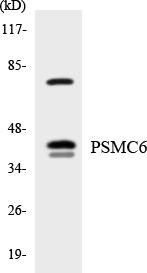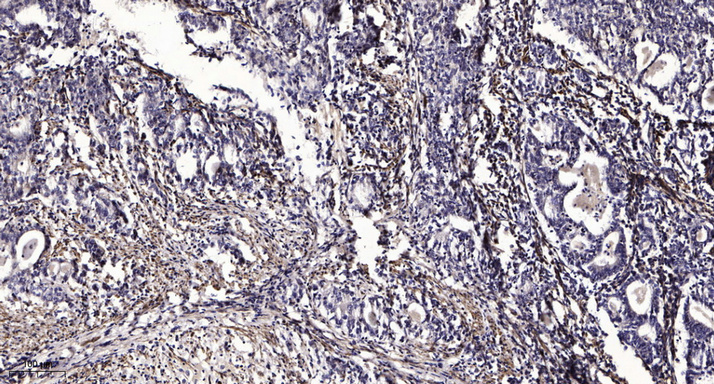PSMC6 Polyclonal Antibody
- Catalog No.:YT3885
- Applications:WB;IHC
- Reactivity:Human;Mouse
- Target:
- PSMC6
- Fields:
- >>Proteasome;>>Alzheimer disease;>>Parkinson disease;>>Amyotrophic lateral sclerosis;>>Huntington disease;>>Spinocerebellar ataxia;>>Prion disease;>>Pathways of neurodegeneration - multiple diseases;>>Epstein-Barr virus infection
- Gene Name:
- PSMC6
- Protein Name:
- 26S protease regulatory subunit 10B
- Human Gene Id:
- 5706
- Human Swiss Prot No:
- P62333
- Mouse Gene Id:
- 67089
- Mouse Swiss Prot No:
- P62334
- Immunogen:
- The antiserum was produced against synthesized peptide derived from human PSMC6. AA range:61-110
- Specificity:
- PSMC6 Polyclonal Antibody detects endogenous levels of PSMC6 protein.
- Formulation:
- Liquid in PBS containing 50% glycerol, 0.5% BSA and 0.02% sodium azide.
- Source:
- Polyclonal, Rabbit,IgG
- Dilution:
- WB 1:500-2000;IHC 1:50-300
- Purification:
- The antibody was affinity-purified from rabbit antiserum by affinity-chromatography using epitope-specific immunogen.
- Concentration:
- 1 mg/ml
- Storage Stability:
- -15°C to -25°C/1 year(Do not lower than -25°C)
- Other Name:
- PSMC6;SUG2;26S protease regulatory subunit 10B;26S proteasome AAA-ATPase subunit RPT4;Proteasome 26S subunit ATPase 6;Proteasome subunit p42
- Observed Band(KD):
- 44kD
- Background:
- proteasome 26S subunit, ATPase 6(PSMC6) Homo sapiens The 26S proteasome is a multicatalytic proteinase complex with a highly ordered structure composed of 2 complexes, a 20S core and a 19S regulator. The 20S core is composed of 4 rings of 28 non-identical subunits; 2 rings are composed of 7 alpha subunits and 2 rings are composed of 7 beta subunits. The 19S regulator is composed of a base, which contains 6 ATPase subunits and 2 non-ATPase subunits, and a lid, which contains up to 10 non-ATPase subunits. Proteasomes are distributed throughout eukaryotic cells at a high concentration and cleave peptides in an ATP/ubiquitin-dependent process in a non-lysosomal pathway. An essential function of a modified proteasome, the immunoproteasome, is the processing of class I MHC peptides. This gene encodes one of the ATPase subunits, a member of the triple-A family of ATPases which have a chaperone-like activity. Pseudogenes have been identified on chrom
- Function:
- function:The 26S protease is involved in the ATP-dependent degradation of ubiquitinated proteins. The regulatory (or ATPase) complex confers ATP dependency and substrate specificity to the 26S complex.,similarity:Belongs to the AAA ATPase family.,subunit:Found in the multi-protein complexes: the 26S proteasome (formed from the 20S proteasome and PA700), and the modulator. PA700 consists of 28 subunits arranged to form a cylinder-shaped complex by four stacked rings, each containing seven subunits. Interacts with PAAF1.,
- Subcellular Location:
- Cytoplasm . Nucleus .
- Expression:
- Aorta,Urinary bladder,
- June 19-2018
- WESTERN IMMUNOBLOTTING PROTOCOL
- June 19-2018
- IMMUNOHISTOCHEMISTRY-PARAFFIN PROTOCOL
- June 19-2018
- IMMUNOFLUORESCENCE PROTOCOL
- September 08-2020
- FLOW-CYTOMEYRT-PROTOCOL
- May 20-2022
- Cell-Based ELISA│解您多样本WB检测之困扰
- July 13-2018
- CELL-BASED-ELISA-PROTOCOL-FOR-ACETYL-PROTEIN
- July 13-2018
- CELL-BASED-ELISA-PROTOCOL-FOR-PHOSPHO-PROTEIN
- July 13-2018
- Antibody-FAQs
- Products Images

- Western Blot analysis of various cells using PSMC6 Polyclonal Antibody

- Western blot analysis of lysates from HepG2, 293, and RAW264.7 cells, using PSMC6 Antibody. The lane on the right is blocked with the synthesized peptide.

- Western blot analysis of the lysates from HeLa cells using PSMC6 antibody.

- Immunohistochemical analysis of paraffin-embedded human Gastric adenocarcinoma. 1, Antibody was diluted at 1:200(4° overnight). 2, Tris-EDTA,pH9.0 was used for antigen retrieval. 3,Secondary antibody was diluted at 1:200(room temperature, 45min).



